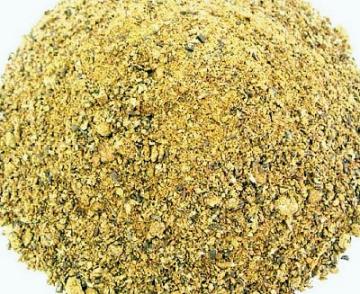
Cottonseed meal (Gossypium arboreum)
Common name: Cotton
Local names: Hindi: Kapas Marathi: Kapus Tamil: Parutthi
Cotton, belonging to genus Gossypium, is widely distributed in temperate and tropical regions. It is a native of Northwest India and Pakistan. Like groundnut cake ghani pressed, expeller pressed and solvent extracted cotton seed cakes are available for feeding the livestock. In cotton growing belt it is the main source of protein to the livestock.
Nutritive value
Nutritional value of cottonseed meal depends up on method of extraction, proportion of husk and lint and degree of decortication. The protein content of cottonseed meal varies from about 22% in meal made from undecorticated cottonseed to 42% in meal made from decorticated seed. The decorticated cottonseed meal contains 41% CP and 78% TDN. The crude fibre content ranges from 2-2.7% in glandless and 7.9-16.0% in decorticated to 26.9% in undecorticated form. Ether extract content varies from 4.2-11.3% in expeller and 0.9-2.9% in solvent extracted meals. Protein degradability of cottonseed meal is similar to or slightly less than soybeans (57% vs 65%). In comparison to other oil seed cakes, cotton seed cake has relatively high phosphorus content. Lysine is the most limiting amino acid in cottonseed meal (Sastry, 2002).
Deleterious factor
Cottonseed and its products contain an anti-nutritional factor, Gossypol polyphenolic compound found exclusively in discrete bodies called ‘pigment glands’ which are distributed in leaves, stems, roots and seeds. Out of 15 gossypol pigments, the yellow pigment gossypol is the predominant naturally occurring which is chemically 1, 1’, 6-6’, 7-7’ hexahydroxy-5-5’-diisopropyl-3-3’-dimethyl (2,2’-binapthalene)-8-8’ dicarboxaldehyde. Gossypol content in different products depends on species, variety, location, year of growth, maturity, length or condition of storage and method of processing.
Ruminants are less susceptible to gossypol toxicity because of the detoxification mechanism present in the rumen. In rumen, there is binding of free gossypol with soluble protein (mostly to epsilon amino group of lysine) which is resistant to proteolytic enzymes secreted in lower gut. Ruminants can become susceptible to gossypol toxicity only if either rumen detoxification mechanism is bypassed or if they receive higher gossypol than the capacity of rumen microbes to detoxify it. Gossypol exerts partially reversible anti-fertility effect in male animals. Death from gossypol toxicity is partially attributed to reduced oxygen carrying capacity of blood and haemolytic effect on erythrocytes and exerts its toxic effect in animals by uncoupling of respiratory linked oxidative phosphorylation. Besides gossypol, contamination of cottonseed meal with aflatoxin can be a problem in some areas.
Detoxification
There are various methods available for detoxification of cottonseed meal. Out of which, hydraulic or expeller processing, cooking or moist heat treatment results in binding and inactivation of gossypol which is in free form in seed, giving rise to ‘bound’ and ‘free’ gossypol. During processing free gossypol binds with protein thereby reducing protein quality, especially lysine availability.
Detoxification of cottonseed meal with either metallic ions like Ca and Fe, roasting, cooking, autoclaving or supplementation with lysine and methionine or fermentation with Aspergillus oryzae may prove beneficial in reducing the free gossypol content and its toxic effect. Some workers showed that out of various physical (cooking) and chemical (lime, iron) treatments, the detoxification of cottonseed meal with 1% Ca(OH) was found to be satisfactory in small ruminants (Agrawal, 2002).
Inclusion
Palatability and availability makes cottonseed meal a very common protein supplement. It can replace 100% soybean meal in ration when economics is to be considered. Cottonseed meal can be safely included up to 15% in total ration of cattle.
